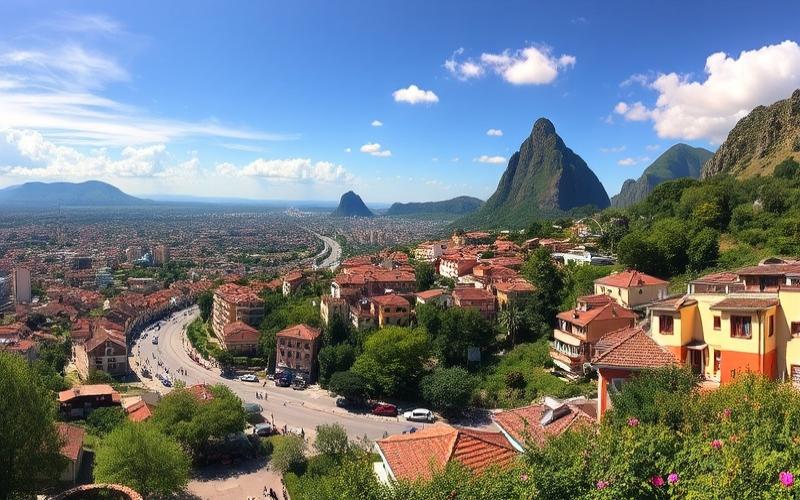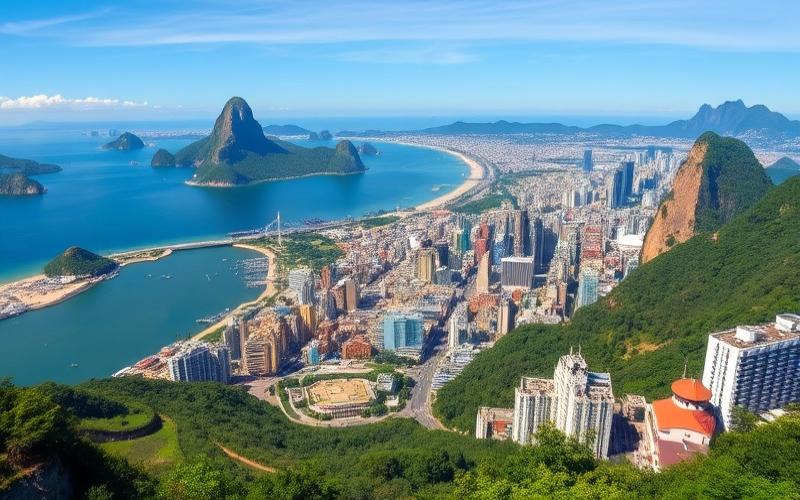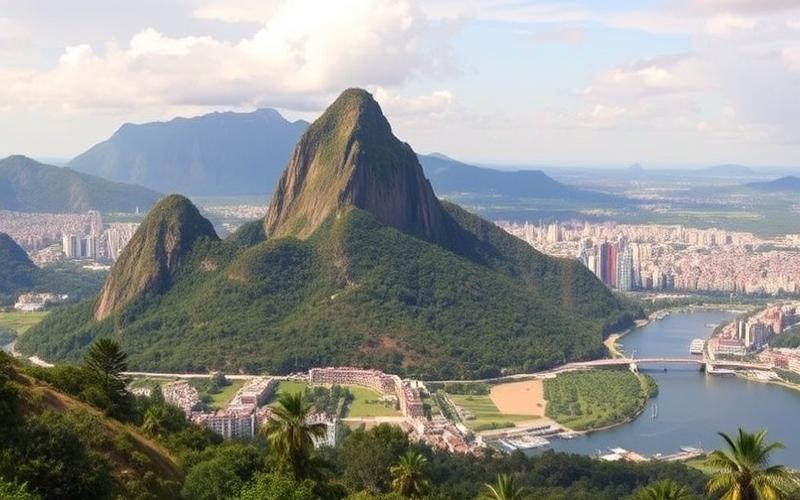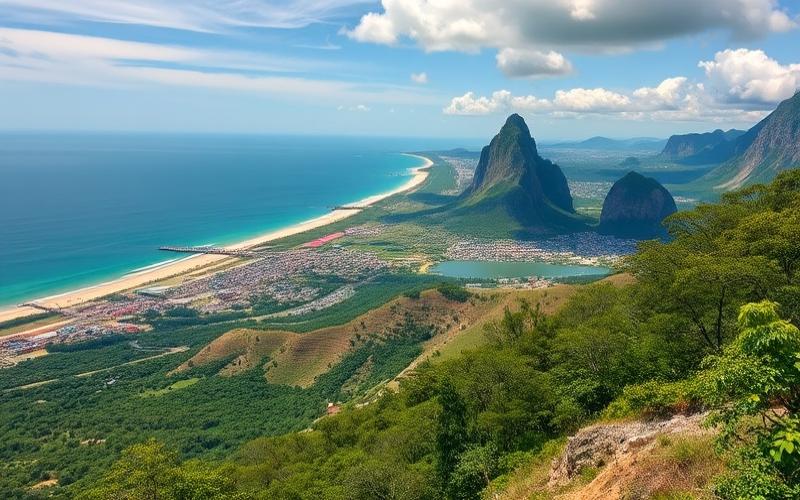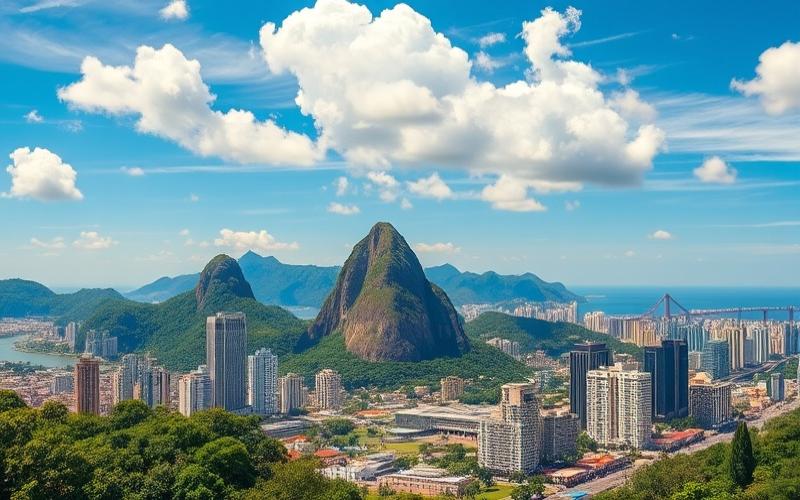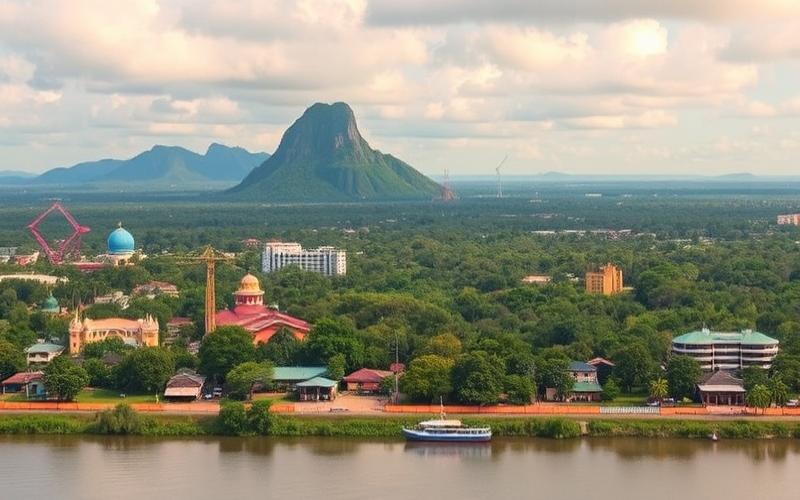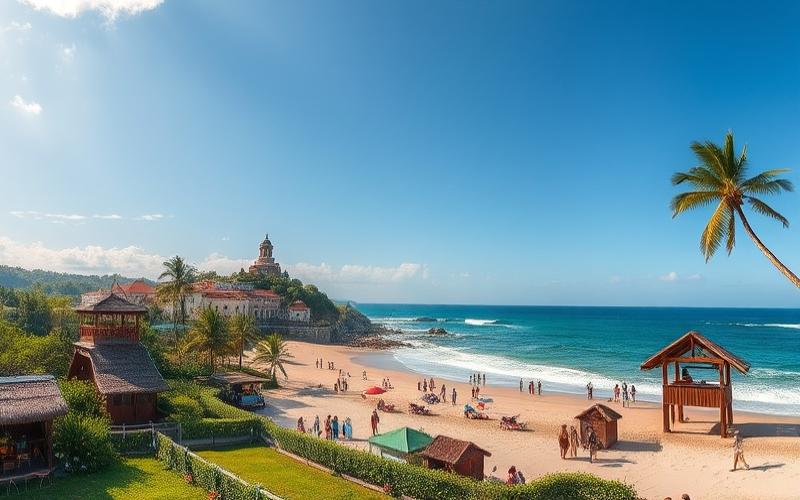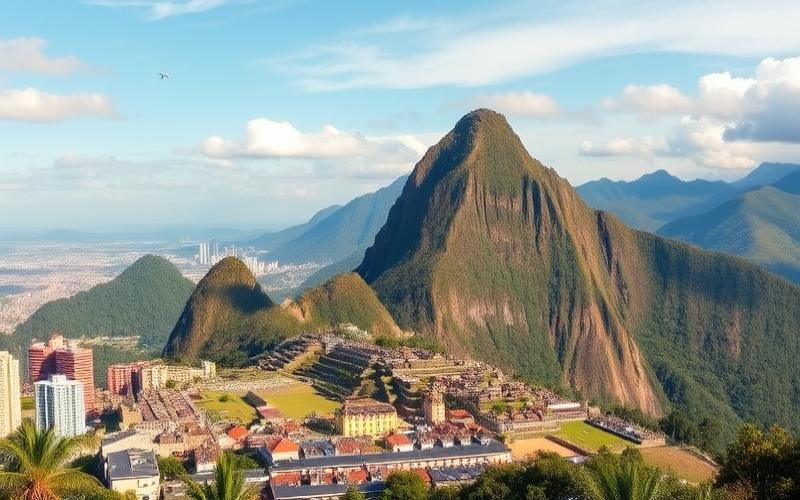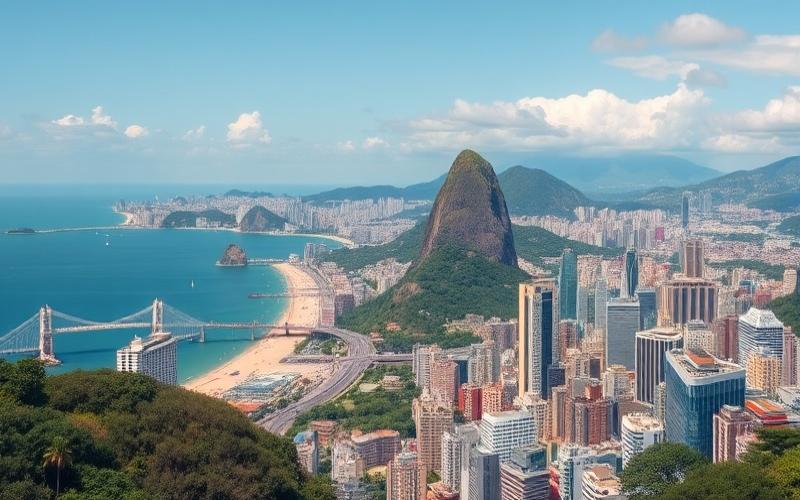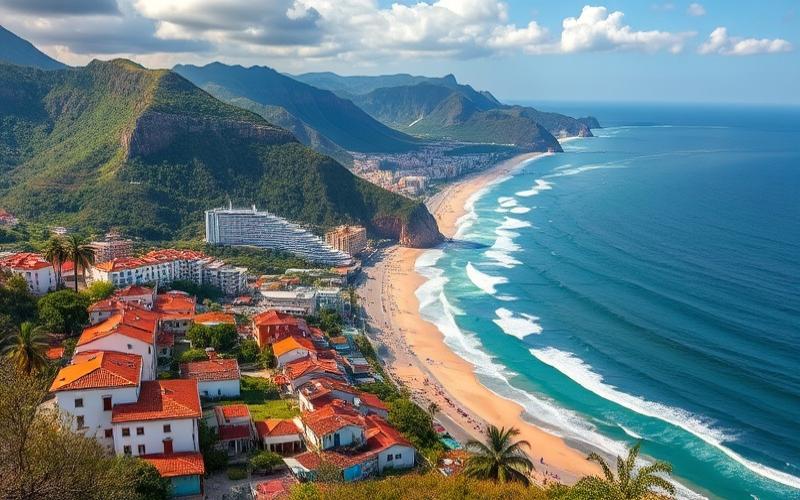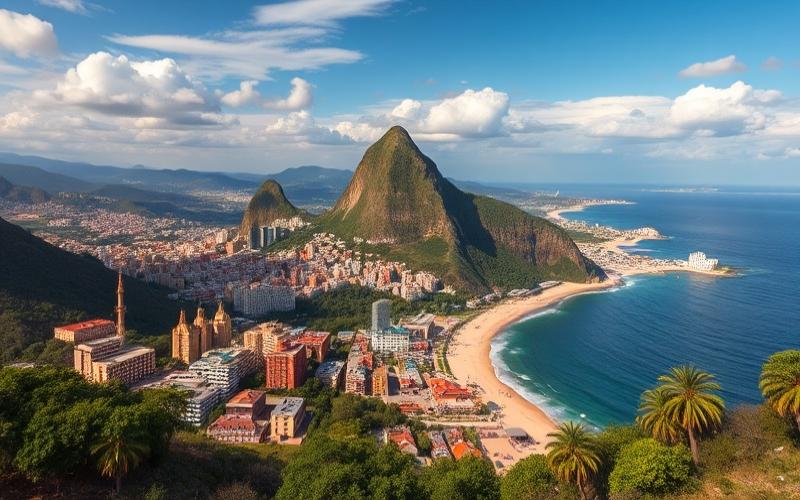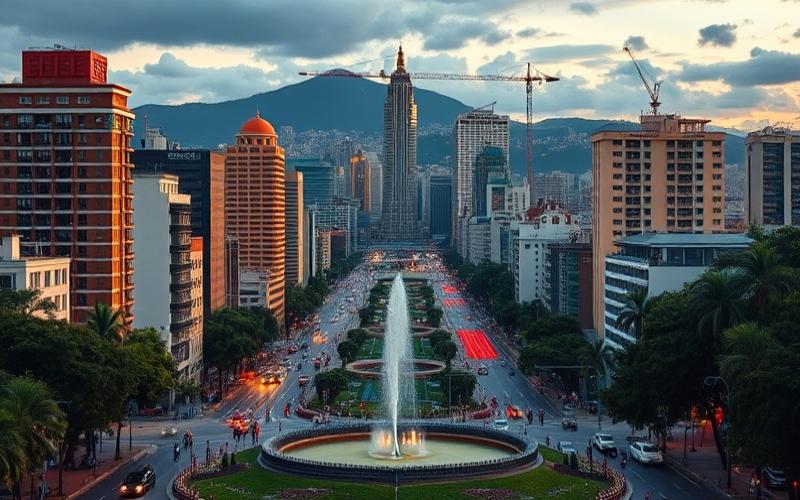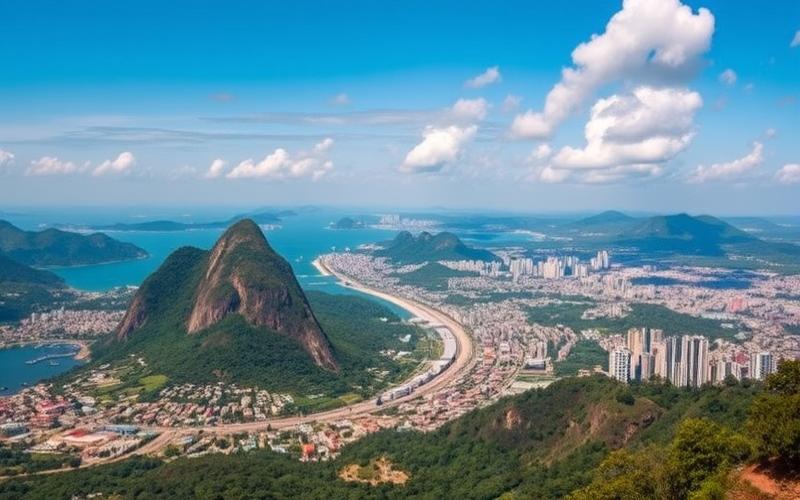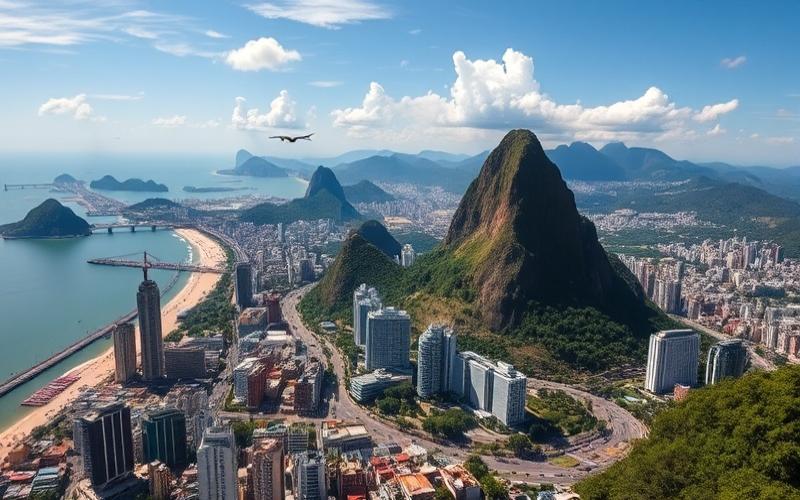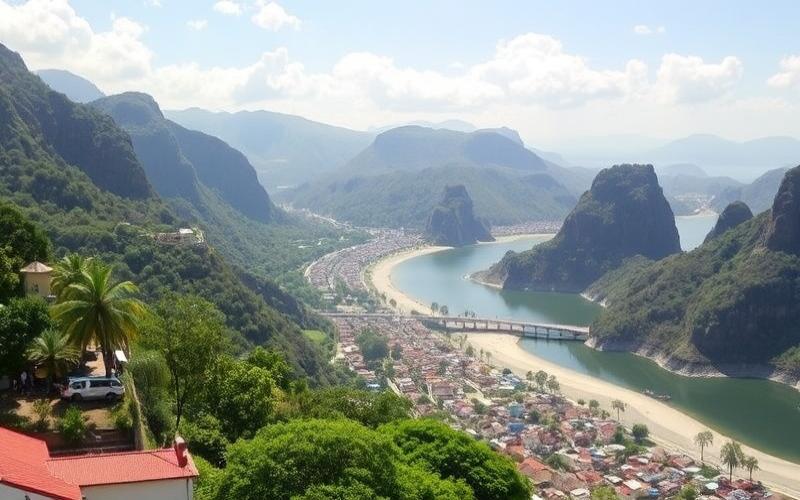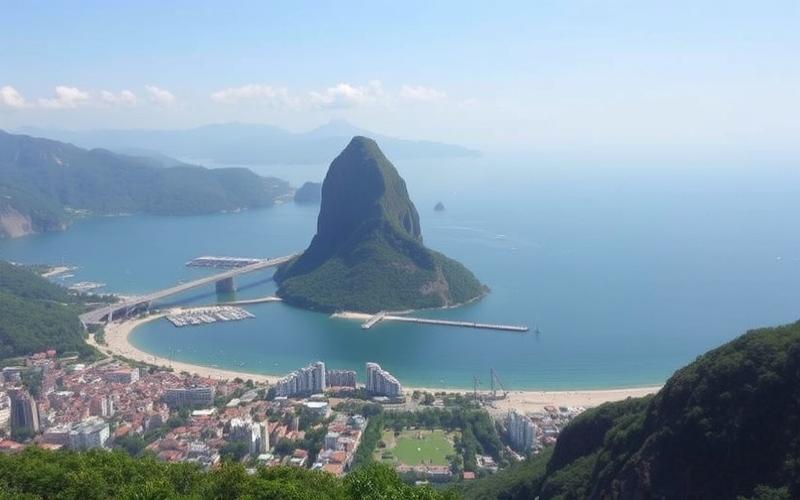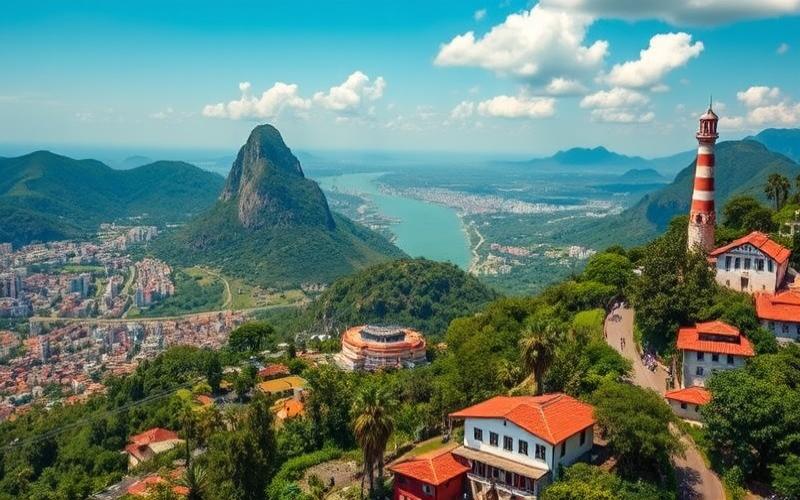
 Published on and written by Cyril Jarnias
Published on and written by Cyril Jarnias
In a country as vast and dynamic as Brazil, investing in parking facilities offers a unique opportunity to benefit from stable returns and diversify one’s real estate portfolio. Major metropolises like São Paulo and Rio de Janeiro, suffering from congestion and challenges related to rapid urbanization, make parking spaces a valuable and rare commodity.
Through this article, we will analyze how the Brazilian market, with its growing middle class and increased motorization, can offer attractive profitability for those looking to invest in urban infrastructure. Exploring key economic factors, real estate trends, and legal aspects, this study aims to provide a thorough understanding of the potential benefits of investing in this expanding sector.
Why Investing in Parking Facilities in Brazil is a Profitable Opportunity
The rapid urban growth in Brazil has concentrated nearly 87% of the population in very constrained urban areas of the territory, intensifying pressure on space and services, including parking. This urbanization, shaped by the automobile and sprawl along road axes since the 1960s, has stimulated the use of private vehicles and lengthened commute distances, mechanically reinforcing the demand for parking facilities.
Key Factors Driving Parking Demand
- Urban densification: urban areas cover ~0.31% of the territory but house the vast majority of inhabitants, which makes central land scarce and increases the value of parking locations.
- High motorization: Brazil ranks among the most motorized countries in the region, which increases road saturation and the demand for destination and turnover parking spaces.
- Metropolitan sprawl: automobile-oriented urban planning has lengthened travel times and favored the use of private vehicles, creating sustained demand for parking near employment and transit hubs.
- Continuous urban growth: the urban population continues to grow (urban annual growth ~0.66% in 2024), fueling the base of potential parking customers.
Economic Trends Supporting Infrastructure Investment (Including Parking)
- Urban demographic dynamics: capturing growing user flows in dense environments improves occupancy rates and income resilience against cycles.
- Rising land prices and pressure: the supply of central land is decreasing, favoring the appreciation of well-located parking assets and the possibility of increasing rates on premium spots.
- Climate and mobility policies: development and transport programs linked to national GHG reduction goals stimulate infrastructure modernization (management systems, park-and-ride facilities), creating targeted investment opportunities.
Recent Data on Motorization and Private Vehicles
- The country has one of the highest motorization rates in Latin America, which impacts air quality and illustrates the strong dependence on cars, with a direct impact on parking demand.
- The growth of the urban population, even moderate in percentage, adds a net flow of urban residents as potential parking users each year.
Local Public Policies Positively Influencing the Market
- Metropolises, faced with congestion and emissions, are integrating demand management measures (zoning, on-street parking pricing, development of park-and-ride facilities) and transition investments that favor better-located and technologically equipped parking facilities.
- National GHG reduction goals encourage more efficient infrastructure projects (guidance systems, sensors, electrification of spaces), improving the economic attractiveness of modernized parking facilities.
Potential Profitability and Space Scarcity
- The scarcity of land in urban centers increases operators’ ability to implement dynamic pricing, strengthening margins, especially on high-turnover sites (business centers, hospitals, transport hubs).
- Urbanization and motorization trends support high occupancy rates and cash flow visibility, key for stable long-term returns.
Long-Term Profitability Prospects and Passive Benefits for Investors
- Recurring revenue via monthly subscriptions, corporate contracts, and event pricing, with potential for inflation indexing and upsell (EV charging, online reservations).
- Risk diversification through a multi-site portfolio in major metropolitan areas, defensive profile in dense urban contexts, and low substitutability of premium locations.
- Potential for operational improvement (guidance systems, sensors, frictionless payment) that increases revenue per space and reduces operating costs.
Case Studies and Examples in Major Brazilian Cities
- São Paulo and Rio de Janeiro, highly urbanized metropolises, concentrate demand due to their density and the historical organization of mobility around the car, which has favored the establishment and performance of well-located parking assets near key transport axes.
- Automobile-oriented urban projects since Brasília have demonstrated that planning favoring road access generates structural demand for parking in administrative and tertiary hubs.
Table — Support Factors and Effects on Profitability
| Factor | Current Signal | Expected Effect on Parking |
|---|---|---|
| High Urbanization | 87% urban population concentrated on 0.31% of territory | Sustained demand and scarcity of central locations |
| Urban Growth | +0.66% in 2024 | Additional user flows and increased occupancy rates |
| Motorization | Among the highest in the region | High use of destination and relay parking |
| Land Scarcity | Density and pressure in centers | Asset appreciation, pricing power |
| Climate Policies | Modernization and demand management | High ROI CAPEX opportunities (digital, EV) |
Points to Monitor
- Evolution of mobility policies (enhanced public transport, car regulations) that could shift demand towards park-and-ride facilities and require supply adaptations.
- Need to integrate low-emission solutions to align assets with climate goals and avoid regulatory obsolescence.
==> Targeted Return: well-located parking assets in Brazilian metropolises benefit from the density-motorization-scarcity combination, with recurring revenue streams and technological optimization levers, supporting passive income and robust long-term performance prospects.
Good to Know:
Investing in parking facilities in Brazil is a profitable opportunity due to rapid urban growth, particularly in cities like São Paulo and Rio de Janeiro where parking demand is increasing significantly. Urbanization contributes to the scarcity of spaces, making parking a valuable and potentially highly lucrative resource. With a growing number of private vehicles, a 20% increase in recent years according to local statistics, pressure on parking infrastructure continues to grow. Simultaneously, government policies favor the development of urban infrastructure, which supports strategic investments in parking. Case studies in Curitiba show significant return on investment thanks to advantageous passive income. Finally, current economic trends reinforce the viability of these long-term investments, promising stable profitability prospects.
The Best Brazilian Cities to Maximize Parking Space Returns
The Brazilian cities offering the best return potential for parking spaces are primarily the major metropolises São Paulo and Rio de Janeiro, as well as hubs with high airport and tourist intensity like Curitiba, Florianópolis, and Porto Alegre, where demand is supported by a combination of urban density, tourist flows, and mobility hubs.
Parking Demand (Key Drivers)
São Paulo: concentration of jobs, high congestion, early adoption of smart parking solutions, availability of data and reservation platforms indicating organized and solvent demand.
Rio de Janeiro: strong tourist appeal and concentrated usage by neighborhoods (Copacabana, Ipanema, Leblon), generating seasonal and hourly demand peaks, with a car access culture in the South and West zones.
Curitiba, Florianópolis, Porto Alegre: regional and airport hubs where airport and downtown parking capture captive demand at premium rates. Florianópolis features coastal tourist urbanization with land pressure and seasonal traffic, increasing parking demand in beach areas and coastal axes.
Estimated Average Occupancy Rates (Existing Parking Facilities)
Airport Hubs (São Paulo GRU/CGH urban periphery; Curitiba, Florianópolis, Porto Alegre): sustained occupancy on weekdays and high season, often higher than purely commercial hubs, indicator reflected by the implementation of management/booking solutions on these sites.
Beach neighborhoods in Rio and tourist areas of Florianópolis: very high occupancy on weekends and during high tourist season, with recurrent saturation of spots near beaches.
Business centers in São Paulo: high occupancy during peak hours and weekdays, preferred target for digital parking management systems.
Note: these occupancy levels are deduced from market indicators (presence of smart parking solutions, tourist pressure and seasonality) and flow observations; official aggregated occupancy statistics by city are not published centrally.
Average Parking Prices (Market Indications)
São Paulo: the deepest and highest-priced market, with supply connected to reservation platforms and private/airport parking, signals high hourly and daily rates and an ability to monetize through dynamic management.
Rio: pricing gradients by neighborhood; premium coastal areas with sustained pricing, and increased monetization during high tourist season.
Curitiba, Florianópolis, Porto Alegre: prices linked to airport/downtown accessibility, with attractive levels for operators where competition is lower and demand is captive.
Note: in the absence of unified public rate schedules, price levels are inferred by market structure (airports, premium zones, use of platforms).
Urban Growth Trends and Impact on Demand
Coastal tourist urbanization: in Florianópolis, tourism-oriented urban expansion densifies coastal fronts and increases seasonal motorization, which boosts parking demand in beach areas and commercial centers.
Metropolitanization and hubs: in regional capitals and mega-cities, the concentration of activities and integration of smart parking solutions favor the formalization of supply and increased monetizable occupancy.
Parking management market: globally sustained growth of the management sector, indicating rising unit revenues through technologies (guidance, reservation, pricing), which improves margins and ROI of assets in major Brazilian cities.
Relevant Local Initiatives and Frameworks
Deployment of smart parking solutions: arrival and availability of digital services in São Paulo and key airports (Curitiba, Florianópolis, Porto Alegre), facilitating dynamic pricing, yield management, and reduced operating costs.
Urban governance and tourism: planning around coastal tourism in Florianópolis highlights space usage tensions and the need for regulated infrastructure, paving the way for regulated and paid parking schemes to manage demand.
Sector trend: professionalization/digitalization of parking management supported by market growth creates a favorable environment for PPPs, concessions, and asset modernization in capitals.
Investment Opportunities and Profitability
São Paulo (CBD, hospitals, university hubs, intermodal hubs): potential for high returns via dynamic pricing and B2B subscriptions; integration with reservation platforms to maximize occupancy and ancillary revenues.
Rio de Janeiro (coastal and central areas): seasonal peaks allowing for higher margins; revenue management strategies focused on weekends/season and partnerships with hotels and concession beaches.
Secondary airports and off-airport parking in Curitiba, Florianópolis, Porto Alegre: captive demand and service bundles (shuttles, online reservation) favor an attractive ROI with moderate CAPEX.
Florianópolis (coastal tourist hubs): monetization of seasonality via peak pricing and packaged offers (beach + parking), subject to local regulatory anchoring and usage conflict management.
Cross-cutting strategies: digitalization (guidance, ANPR, prepayment), contracts with companies (fleets, offices), and reconfiguration of underutilized assets into multi-use parking to increase IRR through higher occupancy rates and average ticket size.
Comparative Table of Target Cities (Investment Potential)
| City | Demand Drivers | Market Assets | Risks/Constraints | Priority ROI Angle |
|---|---|---|---|---|
| São Paulo | Density, CBD, Hospitals, Intermodal | Smart parking ecosystem, solvent clientele | Competition, local regulation | Dynamic pricing, B2B subscriptions |
| Rio de Janeiro | Tourism, Beaches, Events | Premium coastal neighborhoods | Seasonality, local restrictions | Peak pricing, hotel partnerships |
| Curitiba | Airport, Administrative Center | Off-airport parking | Dependence on air traffic | Shuttle + reservation, yield management |
| Florianópolis | Coastal Tourist Urbanization | Strong seasonal demand | Land pressure, usage conflicts | High season rates, beach packages |
| Porto Alegre | Airport, Regional Hub | Captive hubs | Local macro sensitivity | Off-airport + B2B |
Indicators to Monitor Before Investing
- Occupancy rates by micro-zone and time slot (hours/days/seasons) via platform data and digital counts.
- Evolution of tourist flows and waterfront development plans (especially in Florianópolis).
- Schedule of public concessions, local paid parking/zoning rules, and opportunities for modernizing existing assets in capitals.
- Air traffic and airport mobility policies to calibrate the off-airport share.
Consolidated public data on occupancy rates and average prices by city is fragmented; asset evaluation should rely on on-site surveys and local platform data.
Good to Know:
São Paulo, with its economic vibrancy, presents strong potential thanks to parking occupancy rates often exceeding 90%, although an average parking rate of 12 BRL per hour represents a significant investment for users; the city of Rio de Janeiro follows closely with an average occupancy rate of 85%, where the average cost is slightly lower, at 10 BRL per hour, but urban initiatives to reduce individual vehicle usage could influence demand. Salvador and Belo Horizonte, with robust urban growth, offer interesting opportunities, although prices there are lower, at 7 BRL and 8 BRL per hour respectively; these cities benefit from local policies encouraging increased parking infrastructure. Investing in Porto Alegre, however, could be strategically advantageous, where revitalization projects encouraged by local authorities promise to boost parking demand and offer competitive returns on investment.
Comparison Between Investing in Brazilian Parking Facilities and Other Alternative Assets
Parking facilities in Brazil offer an intermediate risk/return profile and moderate liquidity, with growth prospects supported by digitalization (smart/management) and urbanization, while alternative assets like residential real estate offer more stable returns but lower liquidity, agricultural land offers cyclical resilience with low liquidity, and cryptocurrencies offer high expected returns against high volatility and immediate liquidity. Brazilian markets related to parking (smart parking and parking management) show projected CAGRs of 24.8% and 11.7% respectively until 2030, supporting the thesis of improved operational income and value of parking assets in Brazil.
Structured Comparative Analysis
Comparative Table of Key Characteristics
| Asset | Potential Return | Main Risks | Liquidity | Dynamics and Trends |
|---|---|---|---|---|
| Parking (Brazil) | Potentially attractive rental income; levers via dynamic pricing and smart/management solutions; technological sector growth (CAGR 24.8% smart; 11.7% management) | Local demand risk, urban regulation (zones, mobility), upgrade CAPEX (EV charging, sensors), fragmentation | Medium: resale possible but location-dependent; regular cash flow | Urbanization, space pressure, EV needs; digitalization (hardware/service) stimulates efficiency and revenues |
| Residential Real Estate (Brazil) | Rental yields reported around 5–7% in some urban areas, depending on projects and markets | Real estate cycles, interest rates, vacancy, rental regulation; maintenance CAPEX | Low to medium: high sales delays, large tickets | Major urban projects (metro, renovations) can support demand and values in key hubs |
| Agricultural Land | Return linked to land appreciation and leasing; partial inflation hedge | Climate risks, commodity prices, land regulation; technical due diligence | Low: less liquid markets, long processes | Agro-tech transition, food demand; low correlations with stocks/classic real estate |
| Cryptocurrencies | Potentially very high (high beta); opportunities in bullish cycles | Extreme volatility, regulation, technological and counterparty risks | Very high: tradable 24/7 | Halving cycles, variable institutional adoption; occasional decorrelation but own systemic risk |
Specific Characteristics of Brazilian Parking Facilities
- Demand and Digital Transformation
- Smart parking systems market in Brazil: $129.7M in 2023, expected $613.3M in 2030 (CAGR 24.8%); hardware dominated in 2023 and services are the most dynamic segment, reflecting adoption of IoT, guidance, pricing, and predictive maintenance.
- Parking management market: $69.5M in 2023, $150.8M in 2030 (CAGR 11.7%); “solution” most important segment, “service” fastest growing, confirming the rise of SaaS platforms and operational monetization.
- Urban Catalysts
- Major infrastructure and renewal projects (e.g., new Line 6-Orange in São Paulo; Porto Maravilha in Rio; developments in Brasília) support densification, tertiary and residential activity, and thus parking demand, including for electric vehicles and micromobility.
- Comparison of Entry Tickets and Management
- Parking presents a lower entry ticket and simplified rental management compared to traditional residential real estate, a well-documented appeal in mainstream literature on parking, even if often based on European markets; transferability to Brazil will depend on location, legal structure, and service standards.
Return, Risk, Liquidity: Points of Attention by Asset
- Parking (Brazil)
- Return: improvable through optimizations (occupancy, hourly/dynamic pricing, subscriptions, EV services); industrialization via smart/management supports margins.
- Risk: sensitivity to mobility policies (low-emission zones, public transport), platform competition, capex (charging stations, sensors) and technological obsolescence.
- Liquidity: depends on micro-location (CBD, transport proximity, hospitals, universities) and format (single space vs. block asset).
- Residential Real Estate (Brazil)
- Return: benchmarks of 5–7% gross rental yield cited for some areas; may be lower after capex and vacancy.
- Risk: exposure to interest rate cycles; urban projects can create winners/losers depending on access and gentrification.
- Liquidity: lower, high transaction costs.
- Agricultural Land
- Return: leasing + appreciation, generally less volatile; income linked to commodity cycles and productivity.
- Risk: climate, water, legal-land; growing ESG requirements.
- Liquidity: low; technical due diligence essential.
- Cryptocurrencies
- Return: highly dependent on cycles; no intrinsic cash flow.
- Risk: volatility, regulation; variable correlation to risky assets.
- Liquidity: high and continuous; custody and security costs.
Advantages and Disadvantages of Parking vs. Other Assets
- Advantages
- Relatively predictable cash flows in high-demand locations; possibility of short-term re-pricing vs. more rigid residential leases.
- Exposure to megatrends: urbanization, connected mobility, electrification; monetization via services (reservations, subscriptions, charging).
- Entry ticket and operational complexity often lower than classic residential real estate; targeted maintenance.
- Potential Disadvantages
- Dependence on urban regulation and transport supply; need to invest in EV/smart infrastructure to remain competitive.
- Less value creation through structural renovation than residential; sensitivity to short-term demand price elasticity.
International Context and Benchmarks
- Global Trends
- In Europe, investment and development prospects for parking assets receive an average-positive rating according to a 2024 survey of professionals, signaling a cyclical but selective renewed interest by location and operational model.
- Globally, the value chain is shifting towards services (software, analytics, payments), consistent with the more dynamic “service” mix observed in Brazil.
- Brazil’s Positioning
- Brazil follows the same technological upgrade trajectory with double-digit CAGRs on smart/management by 2030, placing the local market among the most dynamic regionally on the technological component of parking.
- Major Brazilian urban projects act as catalysts for parking demand and operational professionalization, bringing the market closer to international standards in key metropolises.
Investor Checklist
- Verify micro-location: density, attraction hubs, infrastructure projects over 5–10 years.
- Evaluate optimization potential: smart/management integration, pricing, EV services.
- Stress-tests: mobility scenarios (public transport, regulated zones), upgrade capex.
- Compare cost of capital and expected liquidity to alternatives (residential 5–7% gross vs. optimized parking; cryptos for speculative allocation).
Brazilian parking facilities combine value creation potential through operations (smart/management) and urban catalysts, positioning the asset between residential real estate and cryptocurrencies in terms of risk/return profile, with intermediate liquidity and direct exposure to mobility and electrification megatrends.
Good to Know:
Investing in parking facilities in Brazil offers a stable potential return of 6 to 8%, with lower risk than cryptocurrencies, but lower liquidity compared to residential real estate. Unlike agricultural land, which requires long-term investments during periods of land price increases, parking generates recurring income with relatively low maintenance costs. In 2023, market studies indicate growing demand for parking, especially in major Brazilian cities, due to rapid urbanization and the increase in the number of vehicles, while residential real estate faces strict regulations and economic fluctuations. Overall, the Brazilian parking market is evolving with favorable trends, influenced by urban needs, which can offer an advantage for investors seeking a tangible and less volatile option than digital assets.
Disclaimer: The information provided on this website is for informational purposes only and does not constitute financial, legal, or professional advice. We encourage you to consult qualified experts before making any investment, real estate, or expatriation decisions. Although we strive to maintain up-to-date and accurate information, we do not guarantee the completeness, accuracy, or timeliness of the proposed content. As investment and expatriation involve risks, we disclaim any liability for potential losses or damages arising from the use of this site. Your use of this site confirms your acceptance of these terms and your understanding of the associated risks.


